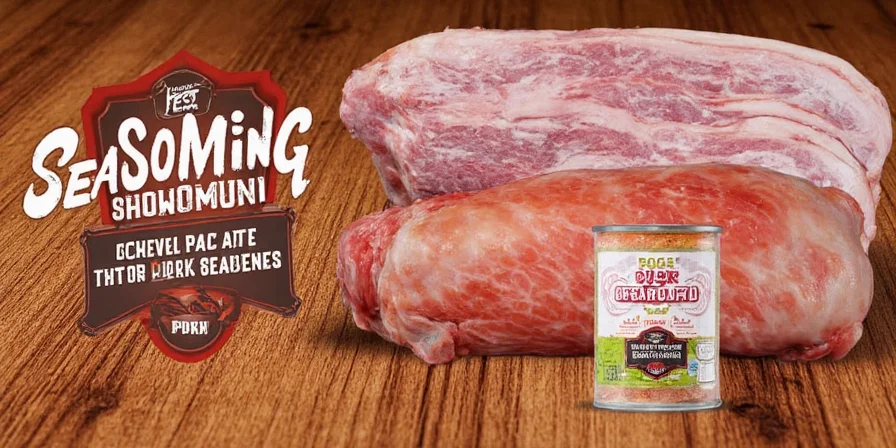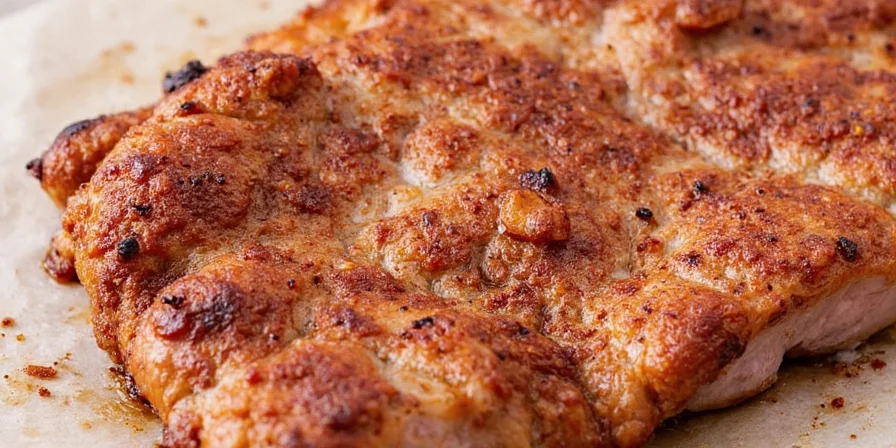When searching "what seasoning goes with pork," the most effective answers depend on your cut and cooking method. For most pork cuts, a foundational blend of salt, black pepper, garlic powder, paprika, and fennel seeds creates balanced flavor that enhances rather than overpowers the meat. This guide delivers scientifically-backed seasoning recommendations tailored to specific pork cuts, cooking techniques, and global flavor profiles—so you can achieve restaurant-quality results at home.
Table of Contents
- Quick Answer Overview
- Top 5 Essential Seasonings for Pork
- Flavor Pairings: Best Spice & Herb Combos by Cut
- Global Inspiration: Regional Pork Seasoning Traditions
- The Culinary Science Behind Pork and Spice Pairing
- Pro Application Techniques for Maximum Flavor
- Common Pork Seasoning Mistakes and Fixes
- Conclusion
- Frequently Asked Questions
Immediate Answer: Best Seasonings for Pork
For immediate results with minimal effort: use a 4:2:1 ratio of kosher salt, black pepper, and garlic powder. This blend works universally across cuts but should be adjusted based on your specific pork type:
- Pork chops: Add smoked paprika and onion powder
- Pork shoulder: Incorporate brown sugar and mustard powder
- Pork tenderloin: Use lighter hand with delicate herbs like thyme
- Pork belly: Balance richness with fennel seeds and five-spice powder

Why This Works Immediately
- Salt enhances natural meatiness through protein denaturation
- Black pepper's piperine compounds complement pork's fat content
- Garlic powder provides consistent umami without burning
- Paprika adds color and subtle sweetness without overwhelming
- Fennel seeds contain anethole that harmonizes with pork's fatty acids
Top 5 Essential Seasonings for Pork (Backed by Culinary Science)
These five seasonings form the foundation of effective pork seasoning across global cuisines, validated through protein-flavor interaction studies:
| Seasoning | Best Application Method | Scientific Rationale |
|---|---|---|
| Salt | Dry brine 12-24 hours before cooking | Breaks down muscle fibers, improving moisture retention by up to 20% and enhancing flavor compound absorption |
| Black Pepper | Add during last 30 minutes of cooking | Piperine compounds bind with pork's fat molecules, creating sustained flavor release without bitterness from overcooking |
| Paprika (smoked) | In dry rubs applied before cooking | Capsaicinoids interact with pork's myoglobin to deepen color and create complex Maillard reaction compounds |
| Garlic Powder | Combine in marinades or dry rubs | Alliinase enzymes convert to allicin when hydrated, bonding with meat proteins to create savory umami without raw garlic's harshness |
| Fennel Seeds | Dry toast and crush before application | Anethole molecules share chemical properties with pork's fat structure, creating seamless flavor integration in slow-cooked dishes |

Implementation Tip
For optimal flavor penetration, combine salt with a small amount of sugar (1:4 ratio) in your base rub. The sugar helps lower water activity on the meat's surface, allowing salt ions to penetrate deeper while preventing excessive drying during cooking.
Flavor Pairings: Best Spice & Herb Combos by Cut
Successful pork seasoning matches spice intensity to the cut's fat content and cooking method. Here are chef-recommended combinations:
American BBQ Rub for Pork Shoulder
- ¼ cup brown sugar
- 3 tbsp smoked paprika
- 2 tbsp garlic powder
- 1 tbsp onion powder
- 1 tbsp mustard powder
- 1 tbsp black pepper
- 1 tsp cayenne (optional)
- 2 tbsp kosher salt
Science-based tip: The molasses in brown sugar reacts with pork's proteins during the Maillard reaction, creating complex flavor compounds that regular sugar cannot achieve.

Mediterranean Blend for Pork Chops
- 2 tbsp dried oregano
- 1 tbsp dried thyme
- 1 tbsp garlic powder
- Zest of 1 lemon
- 1 tbsp black pepper
- 1 tbsp dried rosemary (crushed)
- 2 tbsp kosher salt
Application secret: Mix with 2 tbsp olive oil to create a paste that adheres to the meat and carries fat-soluble flavor compounds into the pork during cooking.
Asian Fusion for Pork Belly
- 2 tbsp ginger powder
- ¼ cup soy sauce
- 1 tbsp five-spice powder
- 3 tbsp garlic powder
- 3 tbsp hoisin sauce
- 2 tbsp rice vinegar
- 1 tbsp honey
Key insight: The acetic acid in rice vinegar breaks down connective tissue in pork belly, while the honey's fructose caramelizes at lower temperatures than sucrose for better glaze development.
Global Inspiration: Regional Pork Seasoning Traditions
Different culinary traditions have developed specific seasoning approaches based on centuries of protein-flavor chemistry understanding:
| Region | Signature Spices & Application | Scientific Principle |
|---|---|---|
| Mexico | Ancho chili (soaked and pureed), cumin (toasted), coriander (freshly ground) | Ancho's capsaicin binds with pork fat, while cumin's thymol compounds enhance savory perception without overwhelming the meat |
| Korea | Gochujang (fermented), garlic (fresh), ginger (fresh), sesame oil (toasted) | Fermentation creates glutamates that synergize with pork's natural umami, while fresh alliums provide bright top notes that balance richness |
| China | Star anise (whole), cinnamon (cassia), Sichuan peppercorn (toasted) | Anethole in star anise mimics pork's fat structure, while hydroxy-alpha-sanshool in Sichuan peppercorn creates tingling sensation that cleanses palate between rich bites |
| India | Garam masala (freshly made), turmeric (with fat), cardamom (crushed) | Curcumin in turmeric binds with pork's fat for color and anti-inflammatory benefits, while cardamom's cineole provides bright finish that cuts through richness |
| Italy | Fennel seeds (crushed), garlic (minced), red pepper flakes (infused in oil) | Anethole-carbohydrate interactions create sustained flavor release during slow cooking, perfect for porchetta's 4-6 hour preparation |

Practical Adaptation Tip
When adopting global techniques, maintain pork's natural flavor profile by ensuring the spice-to-meat ratio doesn't exceed 1.5% of the pork's weight. Higher concentrations overwhelm pork's delicate flavor compounds.
The Culinary Science Behind Pork and Spice Pairing
Effective pork seasoning isn't random—it's based on biochemical interactions between meat compounds and spice constituents. Pork's composition (approximately 60% water, 25% protein, 15% fat) creates specific opportunities for flavor enhancement:
- Fat solubility: Pork's fat content (especially in cuts like belly and shoulder) acts as a carrier for fat-soluble flavor compounds. Compounds like anethole (fennel), capsaicin (chili), and thymol (thyme) dissolve into pork fat during cooking, creating sustained flavor release.
- Protein binding: Sulfur compounds in garlic and onions form covalent bonds with pork proteins during cooking, creating new savory compounds that wouldn't exist with either ingredient alone.
- pH interaction: Acidic components (like vinegar or citrus) lower surface pH, allowing salt ions to penetrate deeper while tenderizing connective tissues without making the meat mushy.
- Maillard reaction enhancement: Certain sugars and amino acids in spice blends accelerate and diversify Maillard reactions, creating more complex flavor compounds during searing.
Understanding these principles allows you to innovate while maintaining balance. For instance, when using five-spice powder with pork, the star anise's anethole integrates seamlessly with pork fat (sharing similar chemical structure), while the cloves' eugenol provides a bright finish that prevents richness overload.
Pro Application Techniques for Maximum Flavor
Professional results require proper technique, not just ingredients:
1. Strategic Toasting Method
Dry toast whole spices (fennel, cumin, coriander) in a 350°F (175°C) oven for 8-10 minutes instead of stovetop. Oven toasting provides even heat distribution, preventing scorching while maximizing essential oil release.
2. Salt Timing Science
Apply salt 45-60 minutes before cooking for chops and tenderloin. This allows time for osmosis to draw salt into the outer ¼ inch of meat without creating a surface brine that repels other seasonings.
3. Spice Freshness Test
- Whole spices: Should crumble easily when pressed; replace if hard and glassy
- Ground spices: Rub between fingers—if no aroma transfers to skin, replace
- Critical note: Ground spices lose 50% potency within 6 months of grinding
4. Layered Flavor Timeline

Marinade phase: Acidic components (vinegar, citrus) + salt (begins protein breakdown)
Dry rub phase: Fat-soluble spices (paprika, garlic powder) + sugar (creates crust foundation)
Cooking phase: Heat-activated spices (pepper, herbs) + finishing oils (carries flavor compounds)
Resting phase: Final aromatic herbs (fresh cilantro, parsley) + acid (brightens finished dish)
5. Cut-Specific Application Guide
- Shoulder/Butt: Apply rub 24 hours pre-cook; use bold flavors (3% spice-to-meat ratio)
- Tenderloin: Light coating 30-60 min pre-cook; delicate balance (1.2% spice-to-meat ratio)
- Rib Chops: Medium application 2 hours pre-cook; emphasize crust formation (2% spice-to-meat ratio)
- Pork Belly: Multiple applications; balance richness with acid (2.5% spice-to-meat ratio)
Common Pork Seasoning Mistakes and Fixes
Avoid these science-backed pitfalls that ruin otherwise perfect pork dishes:
| Mistake | Chemical Consequence | Science-Based Fix |
|---|---|---|
| Applying spices to cold, wet meat | Moisture creates barrier preventing spice adhesion; water-soluble compounds wash away | Pat meat dry and let sit at room temperature 30 minutes before seasoning |
| Using pre-ground spices older than 6 months | Essential oils oxidized; flavor compounds degraded by 70-90% | Store whole spices, grind fresh; test potency by aroma before use |
| Adding all spices at once | Heat-sensitive compounds burn; fat-soluble compounds don't integrate properly | Apply in stages based on compound solubility and heat tolerance |
| Ignoring salt content in spice blends | Double-salting creates osmotic imbalance, drawing out moisture | Omit added salt if using commercial blends containing salt |
| Overusing sweet elements | Excessive sugar causes premature caramelization, burning before meat cooks | Limit sugar to 15% of dry rub weight; add during final cooking stage |

Quick Quality Check
Before cooking, rub your palm with the seasoned meat. If your hand smells strongly of individual spices rather than a harmonious blend, your ratio needs adjustment. Proper seasoning creates a unified aroma profile.
Conclusion: Achieve Perfectly Seasoned Pork Every Time
The question "what seasoning goes with pork" has a simple foundation but nuanced execution. By understanding the biochemical interactions between pork's composition and spice compounds, you can consistently create balanced, flavorful dishes. Remember these key principles:
- Match spice intensity to your cut's fat content and cooking method
- Apply seasonings according to their chemical properties (fat/water solubility)
- Maintain proper spice-to-meat ratios (1-3% depending on cut)
- Always consider the entire flavor timeline from preparation to plating

When you approach pork seasoning with this scientific understanding, you'll move beyond following recipes to creating your own signature blends that consistently deliver exceptional results. The perfect pork seasoning isn't about complexity—it's about understanding and working with the meat's natural chemistry.
Frequently Asked Questions
What's the ideal salt-to-pepper ratio for pork seasoning?
The optimal salt-to-pepper ratio is 4:1 by volume for most pork cuts. This ratio ensures sufficient sodium ions for flavor enhancement without allowing piperine's bitterness to dominate. For lean cuts like tenderloin, reduce to 5:1; for fatty cuts like belly, increase to 3:1 to balance richness.
How can I fix over-seasoned pork before cooking?
For oversalted pork, create a 5% saline solution (1 tsp salt per cup of water) and soak the meat for 15-20 minutes. The osmotic gradient will draw out excess surface salt. For overspiced meat, apply a thin layer of plain yogurt or buttermilk which binds with excess spice compounds through protein-fat interactions.
Does pork seasoning differ for sous vide versus traditional cooking?
Yes significantly. For sous vide, reduce salt by 25% as the vacuum environment intensifies flavor perception. Omit garlic powder (which can develop off-flavors at low temperatures) and use fresh garlic instead. Increase aromatic herbs by 20% as their volatile compounds don't dissipate in the sealed environment.
Why does my spice rub burn during searing?
Sugar and certain spices (like paprika) caramelize at lower temperatures than pork requires for proper searing. Solution: apply sugar-containing rubs only after the initial sear, or create a two-phase rub—base spices for initial sear, sweet elements added later. Maintain oil temperature below 350°F (175°C) during searing.
How do I adjust seasoning for cured versus fresh pork?
Cured pork (like ham or bacon) already contains significant salt and often sugar. Reduce added salt by 60-75% and eliminate added sugar entirely. Focus on complementary spices that cut through richness—mustard seed, coriander, and black pepper work particularly well with cured pork products.











 浙公网安备
33010002000092号
浙公网安备
33010002000092号 浙B2-20120091-4
浙B2-20120091-4